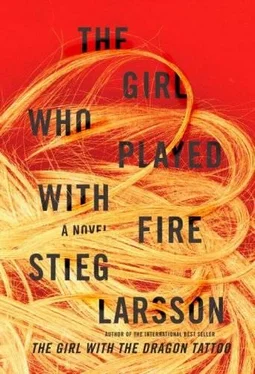The brothers Atho and Harry Ranta were typical: two useless parasites who had found out way too much about the business. Most of all he would like to tie them up with chains and dump them in the harbour. Instead he had driven them to the Estonia ferry and patiently waited until it sailed. Their little vacation was the result of some fucking reporter sticking his nose into their business, and it was decided that they had better make themselves scarce.
He sighed.
Above all he did not appreciate diversions like that Salander girl. She was utterly without interest as far as he was concerned. She represented no profit whatsoever.
He did not like Bjurman, and he could not imagine why they had decided to do what he wanted. But now the ball was rolling. Instructions had been issued, the contract had been awarded to a freelancer from Svavelsjö MC, and he did not like the situation one bit.
He looked out across the dark field, tossing his cigarette butt into the gravel by the gate. He thought he saw movement out of the corner of his eye and froze. He focused his gaze. There was no light except from a faint crescent moon and the stars, but he could still make out the contours of a black figure creeping towards him about a hundred feet away. The figure advanced, making short pauses.
The man felt a cold sweat on his brow. He hated the creature in the field. For a minute he stared spellbound at its steady approach. When it was close enough that he could see its eyes glimmer in the darkness he spun round and ran to the car. He tore open the door. He felt his panic growing until he got the engine started and turned on the headlights. The creature had come out to the road and at last he could make out features in the beam. It looked like an enormous sting ray slithering along. It had a stinger like a scorpion.
The creature was not of this world. It was a monster from the underworld.
He put the car in gear and screeched off. As he passed the creature he saw it strike, but it did not touch the car. He did not stop shaking until several miles later.
Salander spent the night going over the research that Svensson and Millennium had compiled about trafficking. Gradually she was getting a good overview, even though it was based on cryptic fragments that she had to piece together from their various documents.
Berger sent an email to Blomkvist asking how the confrontations were going; he replied briefly that they could not run the man from the Cheka to earth. Salander took this to mean that one of the people who was going to be hung out to dry worked at Säpo, the Security Police. Eriksson sent a summary of a supplementary research assignment to Svensson with copies to Blomkvist and Berger. Svensson and Blomkvist replied with comments and suggestions. Blomkvist and Svensson exchanged emails a few times each day. Svensson described a confrontation he had had with a journalist, Per-Åke Sandström.
From Svensson’s emails she also saw that he was communicating with a person by the name of Gulbrandsen at a Yahoo address. It took her a while to realize that Gulbrandsen was a policeman and that their exchange was off the record, using a private email address instead of Gulbrandsen’s police address. So Gulbrandsen was a source.
The folder named was disappointingly brief, only three Word documents. The longest of them, just 128 KB, was called [Irina P] and gave a sketch of a prostitute’s life, followed by Svensson’s summary of the autopsy report, his curt outline of her appalling wounds.
She recognized a phrase in the text that was a word-for-word quotation from Johansson’s dissertation. There the woman had been called Tamara, but Irina P. and Tamara had to be one and the same, so she read the interview section of the thesis with great interest.
The second document, [Sandström], contained the summary that Svensson had emailed to Blomkvist, showing that the journalist was one of several johns who had abused a girl from the Baltics, and also that he ran errands for the sex mafia in exchange for drugs and sex. Sandström, besides producing company newsletters, had written freelance articles for a daily newspaper indignantly condemning the sex trade. One of his revelations was that an unnamed Swedish businessman had visited a brothel in Tallinn.
Zala was not mentioned in either document, but Salander assumed that since both were in a folder named there must be a connection. The last document was, however, named [Zala]. It was short and only in note form.
According to Svensson, the name Zala had turned up in nine cases related to drugs, weapons, or prostitution since the mid-nineties. Nobody knew who Zala was, but sources had variously indicated that he was a Serb, a Pole, or perhaps a Czech. All the information was secondhand.
Svensson had discussed Zala exhaustively with source G. (Gulbrandsen?) and suggested that Zala may have been responsible for the murder of Irina P. There was no saying what G. thought about this theory, but there was a note to the effect that Zala had been on the agenda a year earlier at a meeting with “the special investigative group on organized crime.” The name had cropped up so many times that the police had started asking questions, trying to establish whether Zala was a real person, and whether he was still alive.
As far as Svensson could discover, the name Zala had first appeared in connection with the holdup of a security van in Örkelljunga in 1996. The robbers had gotten away with more than 3.3 million kronor, but they had so dramatically botched their getaway that after only twenty-four hours the police were able to identify and arrest the gang members. The following day another arrest was made. It was Nieminen, a member of Svavelsjö MC, whose role had been to supply the weapons used in the holdup.
A week after the robbery in 1996, three more people were arrested. The ring thus included eight people, of whom seven had refused to talk to the police. The eighth, a boy of nineteen named Birger Nordman, had broken down and confessed everything he knew during questioning. The trial turned into a runaway victory for the prosecution. One consequence was (Svensson’s police source suspected) that Nordman was found two years later buried in a sandpit in Värmland after running away during temporary leave from prison.
According to G., the police believed that Nieminen had been the catalyst behind the whole gang. They also believed that Nordman had been killed on contract by Nieminen, who was regarded as dangerous and ruthless, but there was no evidence. While in prison he had apparently had dealings with the Aryan Brotherhood, a Nazi prison organization that in turn was linked to the Wolfpack Brotherhood and to ex-con Hell’s Angels clubs around the world, as well as to other cretinous violent Nazi organizations such as the Swedish Resistance Movement.
What interested Salander, however, was something else entirely. Nordman had admitted to police that the weapons used in the robbery had come from Nieminen, and that he in turn had got them from a Serb not known to Nordman whom he named as “Sala.”
Svensson had taken him for an anonymous figure in the criminal scene and reckoned that “Zala” was a nickname. But he warned that they might be dealing with a particularly cunning criminal who operated under an alias.
The last section contained Sandström’s information on Zala, such as it was. Sandström had once talked on the telephone to someone using that name. The notes did not say what the conversation had been about.
At around 4:00 in the morning Salander shut down her Power-Book and sat on her window seat looking out at Saltsjön. She sat quietly for two hours, smoking one cigarette after another, thinking. She had a number of strategic decisions to make – and she had to do a risk assessment.
Читать дальше












